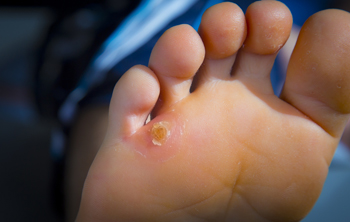Blog - Foot Doctor, Chambersburg and McConnellsburg, PA
Wearing Shoes That Do Not Fit Properly May Cause Corns
A small area of hardened skin that develops on the bottom of the feet or between the toes may be indicative of a corn. A corn can cause severe pain and discomfort, and it generally forms as a result of excessive friction. This friction is typically caused by wearing shoes that do not fit correctly, which can also affect your gait. The corn may diminish in size when wearing properly fitted shoes, or when the activity that caused the friction is temporarily ceased. Some patients find mild relief when a protective pad is worn over the corn. If the corn is severe, it is suggested that you consult with a podiatrist who can offer effective treatment solutions, such as trimming the corn.
Corns can make walking very painful and should be treated immediately. If you have questions regarding your feet and ankles, contact Dr. Steven Schwartz of Pennsylvania. Our doctor will treat your foot and ankle needs.
Corns: What Are They? And How Do You Get Rid of Them?
Corns are thickened areas on the skin that can become painful. They are caused by excessive pressure and friction on the skin. Corns press into the deeper layers of the skin and are usually round in shape.
Ways to Prevent Corns
There are many ways to get rid of painful corns such as:
- Wearing properly fitting shoes that have been measured by a professional
- Wearing shoes that are not sharply pointed or have high heels
- Wearing only shoes that offer support
Treating Corns
Although most corns slowly disappear when the friction or pressure stops, this isn’t always the case. Consult with your podiatrist to determine the best treatment option for your case of corns.
If you have any questions please feel free to contact our offices located in Chambersburg, and Mcconnellsburg, PA . We offer the newest diagnostic and treatment technologies for all your foot and ankle needs.
How Should Dance Shoes Fit?
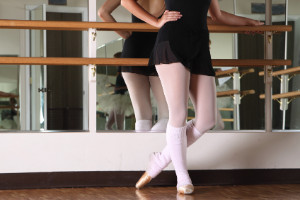 Many people who enjoy ballroom dancing realize the importance of wearing shoes that fit correctly. It is beneficial to have dance shoes fit snugly, and it is suggested to try on shoes that are a half size smaller than your street shoes. Specific foot action is required in many dance steps, and dance shoes are constructed differently than ordinary shoes. Dancers understand that wearing shoes which have a tighter fit may be able to provide more control, and they can feel like they are part of the feet. A perfect fit consists of the toes reaching the top of the shoe with little or no wiggle room. This may help in providing the ability to correctly perform dance steps in which the feet are pointed. If you would like additional information about how to purchase dance shoes that are good for your feet, it is suggested that you consult a podiatrist.
Many people who enjoy ballroom dancing realize the importance of wearing shoes that fit correctly. It is beneficial to have dance shoes fit snugly, and it is suggested to try on shoes that are a half size smaller than your street shoes. Specific foot action is required in many dance steps, and dance shoes are constructed differently than ordinary shoes. Dancers understand that wearing shoes which have a tighter fit may be able to provide more control, and they can feel like they are part of the feet. A perfect fit consists of the toes reaching the top of the shoe with little or no wiggle room. This may help in providing the ability to correctly perform dance steps in which the feet are pointed. If you would like additional information about how to purchase dance shoes that are good for your feet, it is suggested that you consult a podiatrist.
Finding a properly-fitting shoe is important in reducing injuries and preventing foot problems. For more information about treatment, contact Dr. Steven Schwartz from Pennsylvania. Our doctor will treat your foot and ankle needs.
Proper Shoe Fitting
A common concern when it comes to foot health, having properly fitted shoes can help prevent injuries to the foot. Out feet affect our posture and gait, which in turn affects the biomechanics and overall bodily structure. With 33 joints, 26 bones, and over 100 ligaments, the potential for serious injury is much greater than one realizes. Although the feet cease growth in adulthood, they still change shape as they mature. Here are some factors to consider when it comes to investing in proper fitting shoes:
- Be sure the shoes fit correctly right away
- Ensure the ball of your foot fits comfortably in the widest portion of the shoes
- Even though they may look fashionable, improper fitting shoes can either create adverse conditions or exacerbate existing ones you may already have
- Walk along a carpeted surface to ensure the shoes comfortably fit during normal activity
Keeping in mind how shoes fit the biomechanics of your body, properly-fitting shoes are vitally important. Fortunately, it is not difficult to acquire footwear that fits correctly. Be sure to wear shoes that support the overall structure of your body. Do your feet a favor and invest in several pairs of well-fitted shoes today.
If you have any questions please feel free to contact our offices located in Chambersburg, and Mcconnellsburg, PA . We offer the newest diagnostic and treatment technologies for all your foot and ankle needs.
What Is Hyperhidrosis of the Feet?
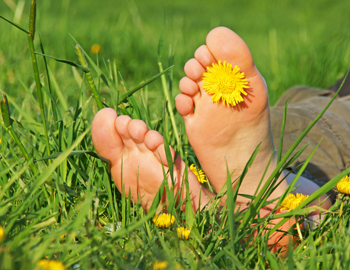 The medical term for excessively sweaty feet is plantar hyperhidrosis. Sweating usually occurs as a cooling mechanism in response to physical activity or stress, but hyperhidrosis occurs when sweating isn't necessary. This sweating is excessive, which can understandably be uncomfortable and embarrassing. Common treatments for plantar hyperhidrosis can include antiperspirant prescriptions, botox injections, iontophoresis, and other medications. If you are struggling with excessively sweaty feet, it is recommended that you consult with a podiatrist for the treatment that is best for you.
The medical term for excessively sweaty feet is plantar hyperhidrosis. Sweating usually occurs as a cooling mechanism in response to physical activity or stress, but hyperhidrosis occurs when sweating isn't necessary. This sweating is excessive, which can understandably be uncomfortable and embarrassing. Common treatments for plantar hyperhidrosis can include antiperspirant prescriptions, botox injections, iontophoresis, and other medications. If you are struggling with excessively sweaty feet, it is recommended that you consult with a podiatrist for the treatment that is best for you.
If you are suffering from hyperhidrosis contact Dr. Steven Schwartz of Pennsylvania. Our doctor can provide the care you need to attend to all of your foot and ankle needs.
Hyperhidrosis of the Feet
Hyperhidrosis is a rare disorder that can cause people to have excessive sweating of their feet. This can usually occur all on its own without rigorous activity involved. People who suffer from hyperhidrosis may also experience sweaty palms.
Although it is said that sweating is a healthy process meant to cool down the body temperature and to maintain a proper internal temperature, hyperhidrosis may prove to be a huge hindrance on a person’s everyday life.
Plantar hyperhidrosis is considered to be the main form of hyperhidrosis. Secondary hyperhidrosis can refer to sweating that occurs in areas other than the feet or hands and armpits. Often this may be a sign of it being related to another medical condition such as menopause, hyperthyroidism and even Parkinson’s disease.
In order to alleviate this condition, it is important to see your doctor so that they may prescribe the necessary medications so that you can begin to live a normal life again. If this is left untreated, it is said that it will persist throughout an individual’s life.
A last resort approach would be surgery, but it is best to speak with your doctor to find out what may be the best treatment for you.
If you have any questions please feel free to contact our offices located in Chambersburg, and Mcconnellsburg, PA . We offer the newest diagnostic and treatment technologies for all your foot and ankle needs.
What Are the Symptoms of Cuboid Syndrome?
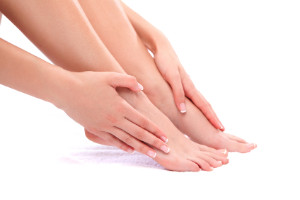 Pain that is felt on the outside of the foot may be indicative of cuboid syndrome. The cuboid bone may become displaced as a result of a sudden injury, or it may gradually become displaced from repetitive overuse. The symptoms that are often associated with this condition can include pain and weakness which can be felt on the outside of the ankle. Additionally, the area may appear to be bruised and swollen, and it can be difficult to walk. The healing process can begin with performing specific stretches that may help to realign the affected joints. If you are experiencing pain in this part of your foot, it is strongly recommended that you consult with a podiatrist who can properly diagnose and treat this condition.
Pain that is felt on the outside of the foot may be indicative of cuboid syndrome. The cuboid bone may become displaced as a result of a sudden injury, or it may gradually become displaced from repetitive overuse. The symptoms that are often associated with this condition can include pain and weakness which can be felt on the outside of the ankle. Additionally, the area may appear to be bruised and swollen, and it can be difficult to walk. The healing process can begin with performing specific stretches that may help to realign the affected joints. If you are experiencing pain in this part of your foot, it is strongly recommended that you consult with a podiatrist who can properly diagnose and treat this condition.
Cuboid syndrome, also known as cuboid subluxation, occurs when the joints and ligaments near the cuboid bone in the foot become torn. If you have cuboid syndrome, consult with Dr. Steven Schwartz from Pennsylvania. Our doctor will assess your condition and provide you with quality foot and ankle treatment.
Cuboid syndrome is a common cause of lateral foot pain, which is pain on the outside of the foot. The condition may happen suddenly due to an ankle sprain, or it may develop slowly overtime from repetitive tension through the bone and surrounding structures.
Causes
The most common causes of cuboid syndrome include:
- Injury – The most common cause of this ailment is an ankle sprain.
- Repetitive Strain – Tension placed through the peroneus longus muscle from repetitive activities such as jumping and running may cause excessive traction on the bone causing it to sublux.
- Altered Foot Biomechanics – Most people suffering from cuboid subluxation have flat feet.
Symptoms
A common symptom of cuboid syndrome is pain along the outside of the foot which can be felt in the ankle and toes. This pain may create walking difficulties and may cause those with the condition to walk with a limp.
Diagnosis
Diagnosis of cuboid syndrome is often difficult, and it is often misdiagnosed. X-rays, MRIs and CT scans often fail to properly show the cuboid subluxation. Although there isn’t a specific test used to diagnose cuboid syndrome, your podiatrist will usually check if pain is felt while pressing firmly on the cuboid bone of your foot.
Treatment
Just as the range of causes varies widely, so do treatments. Some more common treatments are ice therapy, rest, exercise, taping, and orthotics.
If you have any questions, please feel free to contact our offices located in Chambersburg, and Mcconnellsburg, PA . We offer the newest diagnostic and treatment technologies for all your foot care needs.
Should I Get Orthotics?
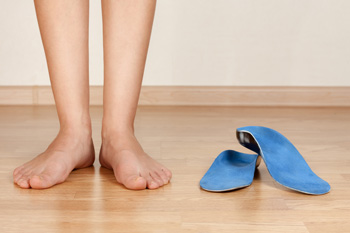 Orthotics are devices made of molded rubber, leather, metal, plastic, or other synthetic material that are placed into the shoes in order to balance the foot in a neutral position and cushion it. A podiatrist may recommend or prescribe a custom orthotic if you have specific foot problems, such as an unusually shaped foot or over pronated feet when walking. They may also be prescribed to help with foot pain caused by medical conditions such as diabetes, plantar fasciitis, and arthritis. If you don’t necessarily want to invest in an expensive custom-made orthotic, drugstores, supermarkets, and sporting goods stores all sell generic orthotics which may help relieve general foot pain. For more information about orthotics, speak with a podiatrist today.
Orthotics are devices made of molded rubber, leather, metal, plastic, or other synthetic material that are placed into the shoes in order to balance the foot in a neutral position and cushion it. A podiatrist may recommend or prescribe a custom orthotic if you have specific foot problems, such as an unusually shaped foot or over pronated feet when walking. They may also be prescribed to help with foot pain caused by medical conditions such as diabetes, plantar fasciitis, and arthritis. If you don’t necessarily want to invest in an expensive custom-made orthotic, drugstores, supermarkets, and sporting goods stores all sell generic orthotics which may help relieve general foot pain. For more information about orthotics, speak with a podiatrist today.
If you are having discomfort in your feet and would like to try orthotics, contact Dr. Steven Schwartz from Pennsylvania. Our doctor can provide the care you need to keep you pain-free and on your feet.
What Are Orthotics?
Orthotics are inserts you can place into your shoes to help with a variety of foot problems such as flat feet or foot pain. Orthotics provide relief and comfort for minor foot and heel pain but can’t correct serious biomechanical problems in your feet.
Over-the-Counter Inserts
Orthotics come in a wide variety of over-the-counter inserts that are used to treat foot pain, heel pain, and minor problems. For example, arch supports can be inserted into your shoes to help correct overarched or flat feet, while gel insoles are often used because they provide comfort and relief from foot and heel pain by alleviating pressure.
Prescription Orthotics
If over-the-counter inserts don’t work for you or if you have a more severe foot concern, it is possible to have your podiatrist prescribe custom orthotics. These high-quality inserts are designed to treat problems such as abnormal motion, plantar fasciitis, and severe forms of heel pain. They can even be used to help patients suffering from diabetes by treating foot ulcers and painful calluses and are usually molded to your feet individually, which allows them to provide full support and comfort.
If you are experiencing minor to severe foot or heel pain, it’s recommended to speak with your podiatrist about the possibilities of using orthotics. A podiatrist can determine which type of orthotic is right for you and allow you to take the first steps towards being pain-free.
If you have any questions please contact our offices located in Chambersburg, and Mcconnellsburg, PA . We offer the newest diagnostic and treatment technologies for all your foot and ankle needs.
What Should I Do if I Have Athlete's Foot?
 Tinea pedis, or Athlete’s foot as it is more commonly known, is a fungal infection of the skin and feet. It typically affects the spaces between the toes and is characterized by cracked, scaly skin. This infection is contagious and can be spread through contact with infected skin flakes or through contact with fungi in damp areas, such as public swimming pools. If you find yourself with athlete’s foot, it is important to keep the feet clean, dry, and cool, as the fungus thrives and multiplies in warm, moist environments. You should also avoid public swimming pools, public showers, and foot baths. Wear sandals if possible, or air out your shoes by alternating them every 2-3 days. Avoid wearing socks made from fabrics like nylon, which do not dry easily. Finally, follow your doctor’s prescribed treatments, which can include topical or oral antifungal medications. If you think that you may have athlete’s foot, it is suggested that you seek the care of a podiatrist.
Tinea pedis, or Athlete’s foot as it is more commonly known, is a fungal infection of the skin and feet. It typically affects the spaces between the toes and is characterized by cracked, scaly skin. This infection is contagious and can be spread through contact with infected skin flakes or through contact with fungi in damp areas, such as public swimming pools. If you find yourself with athlete’s foot, it is important to keep the feet clean, dry, and cool, as the fungus thrives and multiplies in warm, moist environments. You should also avoid public swimming pools, public showers, and foot baths. Wear sandals if possible, or air out your shoes by alternating them every 2-3 days. Avoid wearing socks made from fabrics like nylon, which do not dry easily. Finally, follow your doctor’s prescribed treatments, which can include topical or oral antifungal medications. If you think that you may have athlete’s foot, it is suggested that you seek the care of a podiatrist.
Athlete’s foot is an inconvenient condition that can be easily reduced with the proper treatment. If you have any concerns about your feet and ankles, contact Dr. Steven Schwartz from Pennsylvania. Our doctor will treat your foot and ankle needs.
Athlete’s Foot: The Sole Story
Athlete's foot, also known as tinea pedis, can be an extremely contagious foot infection. It is commonly contracted in public changing areas and bathrooms, dormitory style living quarters, around locker rooms and public swimming pools, or anywhere your feet often come into contact with other people.
Solutions to Combat Athlete’s Foot
- Hydrate your feet by using lotion
- Exfoliate
- Buff off nails
- Use of anti-fungal products
- Examine your feet and visit your doctor if any suspicious blisters or cuts develop
Athlete’s foot can cause many irritating symptoms such as dry and flaking skin, itching, and redness. Some more severe symptoms can include bleeding and cracked skin, intense itching and burning, and even pain when walking. In the worst cases, Athlete’s foot can cause blistering as well. Speak to your podiatrist for a better understanding of the different causes of Athlete’s foot, as well as help in determining which treatment options are best for you.
If you have any questions please feel free to contact our offices located in Chambersburg, and Mcconnellsburg, PA . We offer the newest diagnostic and treatment technologies for all your foot and ankle needs.
Gout 101
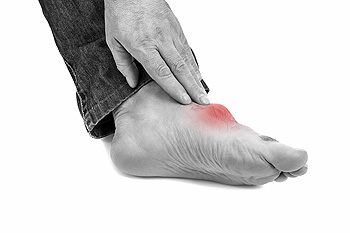 Gout is a form of inflammatory arthritis that affects the big toe and can cause severe joint pain. Gout is three times more likely to affect men than women. A proper diagnosis will require a podiatrist to assess the foot and rule out other possible diagnoses. Upon a gout diagnosis, medications such as anti-inflammatory drugs or corticosteroids may be prescribed. However, the typical primary treatment method for gout involves reducing uric acid levels in the blood. While there are many prescriptions that may help reduce these levels, diet is key. Avoiding high purine foods, sugary drinks, and alcohol will help reduce uric acid levels. If you believe that you are suffering from gout, consult with a podiatrist for a proper diagnosis and treatment.
Gout is a form of inflammatory arthritis that affects the big toe and can cause severe joint pain. Gout is three times more likely to affect men than women. A proper diagnosis will require a podiatrist to assess the foot and rule out other possible diagnoses. Upon a gout diagnosis, medications such as anti-inflammatory drugs or corticosteroids may be prescribed. However, the typical primary treatment method for gout involves reducing uric acid levels in the blood. While there are many prescriptions that may help reduce these levels, diet is key. Avoiding high purine foods, sugary drinks, and alcohol will help reduce uric acid levels. If you believe that you are suffering from gout, consult with a podiatrist for a proper diagnosis and treatment.
Gout is a painful condition that can be treated. If you are seeking treatment, contact Dr. Steven Schwartz from Pennsylvania. Our doctor will treat your foot and ankle needs.
What Is Gout?
Gout is a form of arthritis that is characterized by sudden, severe attacks of pain, redness, and tenderness in the joints. The condition usually affects the joint at the base of the big toe. A gout attack can occur at any random time, such as the middle of the night while you are asleep.
Symptoms
- Intense Joint Pain - Usually around the large joint of your big toe, and it most severe within the first four to twelve hours
- Lingering Discomfort - Joint discomfort may last from a few days to a few weeks
- Inflammation and Redness -Affected joints may become swollen, tender, warm and red
- Limited Range of Motion - May experience a decrease in joint mobility
Risk Factors
- Genetics - If family members have gout, you’re more likely to have it
- Medications - Diuretic medications can raise uric acid levels
- Gender/Age - Gout is more common in men until the age of 60. It is believed that estrogen protects women until that point
- Diet - Eating red meat and shellfish increases your risk
- Alcohol - Having more than two alcoholic drinks per day increases your risk
- Obesity - Obese people are at a higher risk for gout
Prior to visiting your podiatrist to receive treatment for gout, there are a few things you should do beforehand. If you have gout you should write down your symptoms--including when they started and how often you experience them, important medical information you may have, and any questions you may have. Writing down these three things will help your podiatrist in assessing your specific situation so that he or she may provide the best route of treatment for you.
If you have any questions, please feel free to contact our offices located in Chambersburg, and Mcconnellsburg, PA . We offer the newest diagnostic and treatment technologies for all your foot care needs.
Rheumatoid Arthritis and the Feet
 Rheumatoid arthritis (RA) is an autoimmune condition that causes chronic inflammation of the joints and frequently affects the joints of the feet and ankles. In fact, more than 90% of people with RA develop symptoms in the foot and ankle. This condition can make it difficult to walk and may cause pain in the feet. RA can also make you more likely to develop other foot problems, such as collapsed arches, corns, calluses, bunions, hammertoes, and large bony bumps on the ball of the foot,. If you have been diagnosed with RA and experience symptoms in the feet and ankles, it is highly suggested that you are under the care of a podiatrist. A podiatrist can monitor your feet and ankles, prescribe various treatments, and help you maintain your mobility and quality of life.
Rheumatoid arthritis (RA) is an autoimmune condition that causes chronic inflammation of the joints and frequently affects the joints of the feet and ankles. In fact, more than 90% of people with RA develop symptoms in the foot and ankle. This condition can make it difficult to walk and may cause pain in the feet. RA can also make you more likely to develop other foot problems, such as collapsed arches, corns, calluses, bunions, hammertoes, and large bony bumps on the ball of the foot,. If you have been diagnosed with RA and experience symptoms in the feet and ankles, it is highly suggested that you are under the care of a podiatrist. A podiatrist can monitor your feet and ankles, prescribe various treatments, and help you maintain your mobility and quality of life.
Arthritis can be a difficult condition to live with. If you are seeking treatment, contact Dr. Steven Schwartz from Pennsylvania. Our doctor can provide the care you need to keep you pain-free and on your feet.
Arthritic Foot Care
Arthritis is a joint disorder that involves the inflammation of different joints in your body, such as those in your feet. Arthritis is often caused by a degenerative joint disease and causes mild to severe pain in all affected areas. In addition to this, swelling and stiffness in the affected joints can also be a common symptom of arthritis.
In many cases, wearing ill-fitting shoes can worsen the effects and pain of arthritis. Wearing shoes that have a lower heel and extra room can help your feet feel more comfortable. In cases of rheumatoid arthritis, the arch in your foot may become problematic. Buying shoes with proper arch support that contour to your feet can help immensely.
Alleviating Arthritic Pain
- Exercises that stretch the foot can prevent further pain and injury and increase mobility
- Most of the pain can be alleviated with anti-inflammatory drugs, heat, and topical medications
- Massages can help temporarily alleviate pain.
It is best to see your doctor for the treatment that is right for your needs and symptoms. Conditions vary, and a podiatrist can help you determine the right method of care for your feet.
If you have any questions, please feel free to contact our offices located in Chambersburg, and Mcconnellsburg, PA . We offer the newest diagnostic tools and technology to treat your foot and ankle needs.
What Can Cause Achilles Tendon Pain?
 There are multiple conditions that can cause pain in the Achilles tendon, a tough band of tissue that connects the calf muscles to the heel bone. Achilles tendonitis is an inflammation of the tendon, and tends to have a quick onset and pain that may last up to six weeks. Achilles tendinosis is a degeneration of the tendon and is noninflammatory. It is often caused by overuse. Paratenonitis is an inflammation of the tissue that surrounds the Achilles tendon. Insertional Achilles tendinopathy is the inflammation and subsequent degeneration of tendon fibers that insert on the back of the heel bone. If you are experiencing pain at the back of the ankle or in the lower calf, it is suggested that you visit a podiatrist to receive a proper diagnosis and treatment.
There are multiple conditions that can cause pain in the Achilles tendon, a tough band of tissue that connects the calf muscles to the heel bone. Achilles tendonitis is an inflammation of the tendon, and tends to have a quick onset and pain that may last up to six weeks. Achilles tendinosis is a degeneration of the tendon and is noninflammatory. It is often caused by overuse. Paratenonitis is an inflammation of the tissue that surrounds the Achilles tendon. Insertional Achilles tendinopathy is the inflammation and subsequent degeneration of tendon fibers that insert on the back of the heel bone. If you are experiencing pain at the back of the ankle or in the lower calf, it is suggested that you visit a podiatrist to receive a proper diagnosis and treatment.
Achilles tendon injuries need immediate attention to avoid future complications. If you have any concerns, contact Dr. Steven Schwartz of Pennsylvania. Our doctor can provide the care you need to keep you pain-free and on your feet.
What Is the Achilles Tendon?
The Achilles tendon is a tendon that connects the lower leg muscles and calf to the heel of the foot. It is the strongest tendon in the human body and is essential for making movement possible. Because this tendon is such an integral part of the body, any injuries to it can create immense difficulties and should immediately be presented to a doctor.
What Are the Symptoms of an Achilles Tendon Injury?
There are various types of injuries that can affect the Achilles tendon. The two most common injuries are Achilles tendinitis and ruptures of the tendon.
Achilles Tendinitis Symptoms
- Inflammation
- Dull to severe pain
- Increased blood flow to the tendon
- Thickening of the tendon
Rupture Symptoms
- Extreme pain and swelling in the foot
- Total immobility
Treatment and Prevention
Achilles tendon injuries are diagnosed by a thorough physical evaluation, which can include an MRI. Treatment involves rest, physical therapy, and in some cases, surgery. However, various preventative measures can be taken to avoid these injuries, such as:
- Thorough stretching of the tendon before and after exercise
- Strengthening exercises like calf raises, squats, leg curls, leg extensions, leg raises, lunges, and leg presses
If you have any questions please feel free to contact our offices located in Chambersburg, and Mcconnellsburg, PA . We offer the newest diagnostic tools and technology to treat your foot and ankle needs.

